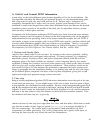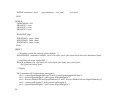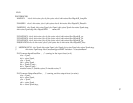
Appendix A.: V-Antenna Optimization Run
This appendix contains a complete worked example of a three-parameter optimization of a 3-D simulation. The device to be
optimized is a V-dipole antenna made of gold, working in free space at a wavelength of 1.58 µm. The parameters being
optimized are the length (in X) and rake (in Z) of the arms of the antenna, and the load resistance applied to the output
terminals. The merit function is the power dissipated in the load. The antenna is illuminated with a modefile source, which
was taken from a similar simulation in which a featureless space with absorbing material boundaries was illuminated by a
plane wave. These files are all part of the POEMS distribution.
The arms of the antenna are diagonal lines, whose length and slope are arbitrary, so we use the fan statement to make them.
To keep them attached to the load, we define the end face positions in terms of user variables, using the same ones for the
fans and the load.
To build the load, we use a block of normal conductor, whose conductivity σ is chosen so that Z
L
=L/(σA), where L is the
length of the load and A is its cross-sectional area. (In the file, these appear as loadlength and loadwidth*loadheight,
respectively.) This depends on the load being a small fraction of a wavelength in size, so that the E field can be assumed
constant inside it. Since tempest doesn’t directly support normal conductors, POEMS uses the constitutive relation for a
normal conductor,
(5.1)
to make the equivalent using a fictitious lossy dielectric. In this example, it’s done manually, but POEMS can also do it for
you, using the conductor material type.
The run will produce lots of bitmaps at appropriately chosen locations.
51


















